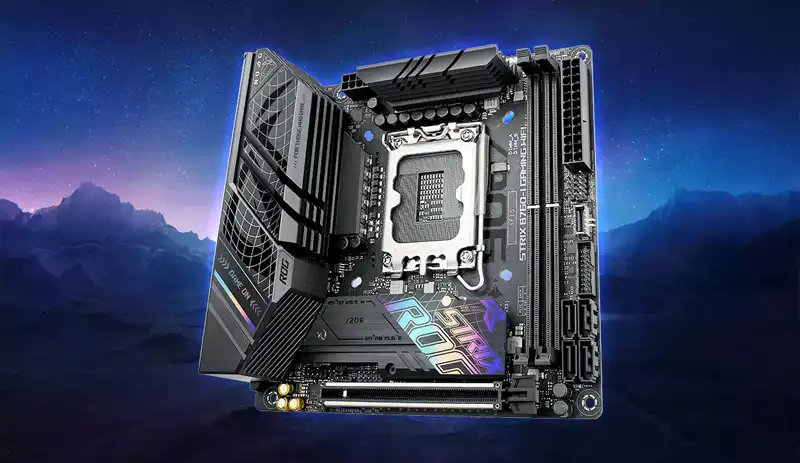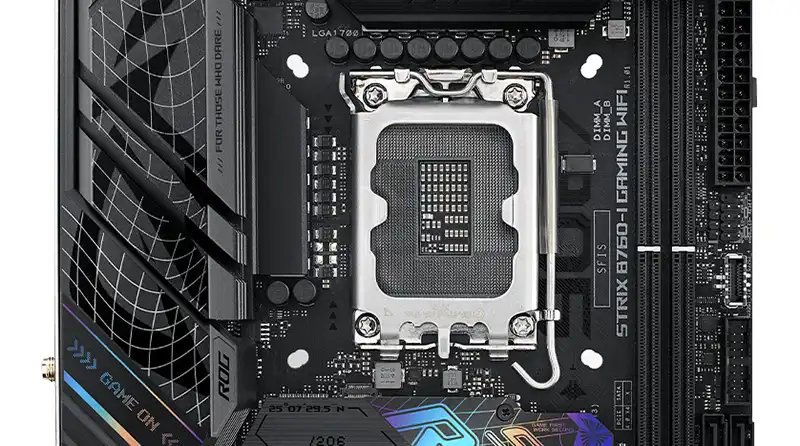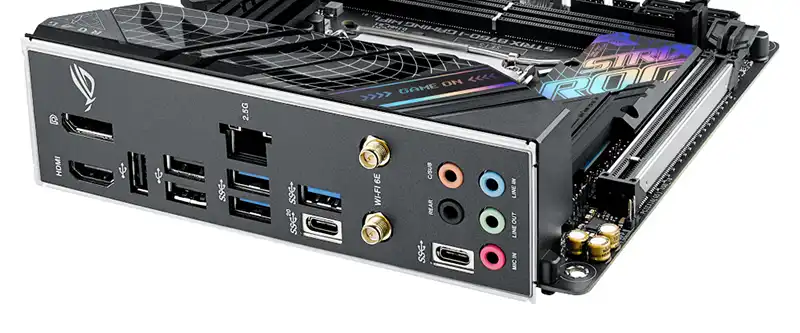You can also be interested in these:
- Asus ROG Strix RTX 4070 Ti OC review
- Asus ROG Hyperion GR701 gaming PC case: A premium choice for gamers
- MSI Z170A Gaming Pro Carbon motherboard review
- MSI 760GMA-P34 (FX) motherboard review
The Asus ROG Strix B760-I Gaming WiFi motherboard is designed to meet the needs of users with compact cases or MiniPCs that require additional power for their locked Intel CPUs, where other Micro ATX models may fall short. In a small space, we have an 8+1+2 phase 80A VRM, dual PCIe Gen4x4 slots, WiFi 6E, 2.5 Gbps LAN, and USB-C Gen2x2, which is practically everything found in the Z790 version.
Exterior design
The aesthetic design of this Asus ROG Strix B760-I Gaming WiFi is more simplified than the Z790 version, which is understandable, given the price difference. Despite being an ITX format, there is still space for a protective cover for the port panel, combining a passive extended aluminum block for the VRM and a plastic extension for the rest of the area. The upper VRM segment features a separate second block.

The second aesthetic element is located above the Q-Latch M.2 slot, acting as a heat sink for it, and in a lower second level, there is another small aluminum block that will passively cool the chipset located just below it. On the rear, we have the second slot, this time without a heat sink, so we need to check if our chassis has a large enough opening to accommodate SSD coolers.
In terms of additional technical details, this motherboard features a PCIe slot with reinforced steel and an enlarged tab, DDR5 slots with sunken soldering on the PCB, and a post boot panel located in the upper right corner. Additionally, there is space for 1 5VDG + 1 12VBRG lighting header.
Voltage regulator module
The Asus ROG Strix B760-I Gaming WiFi features an 8-layer PCB and a configuration of 8 primary phases for Vcore, 1 phase for VccGT, and 2 phases for VccAUX, which will be powered through the ATX connector and another solid 8-pin EPS header.
The DC-DC conversion stage consists of 8 Vishay SiC659A MOSFETs with a nominal power of 80A in direct phase configuration, as well as 2 additional On Semiconductor ALP28CL MOSFETs located in the vertical segment. The PWM control is handled by an EPU DIGI+ ASP2100R. The VRM is completed with a signal smoothing stage consisting of 11 metal-covered chokes and 5K Black Metallic capacitors.
RAM memory and chipset
The Asus ROG Strix B760-I Gaming WiFi features the LGA 1700 socket, currently compatible with 13th Gen Intel Core i processors, as well as Pentium and Celeron models based on the Raptor Lake cores. The Intel B760 chipset allows us to overclock only the memories through XMP profiles, although it also supports CPU overclocking if done through BCLK, with the limitations and risks that it entails.

The B760 chipset is capable of supporting DDR5 RAM, and in this case, the motherboard has 2 slots with a maximum capacity of 64 GB at 7600 MHz of maximum frequency compatible with XMP 3.0 and Asus OptiMem II. The rest of its capabilities will be limited on this board due to insufficient space for all the PCIe slots or connections that it would support on ATX motherboards.
PCIe slots and storage capacity
The internet connectivity distribution in this Asus ROG Strix B760-I Gaming WiFi will be straightforward due to its ITX format. We only have one full-size PCIe slot with its 16 active PCIe 5.0 lanes directly connected to the CPU.
Regarding storage configuration, this motherboard has 2 M.2 slots and a total of 4 SATA ports located in the lower right corner of the board, with a straight orientation instead of the typical 90-degree rotated panel for better access in the chassis. The operating conditions are simple:
- 2_1 is the slot located on the front side of the board, provided with a heat sink. It supports 2280 format and operates with 4 PCIe Gen4 lanes connected to the chipset without a shared bus.
- M.2_2 is located on the backside, supporting 2280 units and operating with 4 PCIe Gen4 lanes connected this time to the CPU.
- The 4 SATA III ports at 6 Gbps are connected to the chipset without sharing a bus with anything else.
Sound card and wireless connectivity
The network connectivity of this Asus ROG Strix B760-I Gaming WiFi remains intact compared to ATX motherboards, as it features an Ethernet port that provides 2.5 Gbps of bandwidth thanks to the Intel I225-V chip. Along with it, we have the Intel Wi-Fi 6E AX211 wireless card, with triple-band support providing 2.4 Gbps for 5 GHz and 6 GHz and 574 Mbps for 2.4 GHz, including Bluetooth 5.3.
Unlike the ROG Strix Z790-I, this motherboard does incorporate the sound card into the PCB, using a Realtek S1220A codec and a Savitech SV3H712 amplifier that supports stereo playback at 120 dB SNR and recording at 113 dB SNR up to 32 bits/192 kHz. It also incorporates an impedance sensor in the front and rear headphone output, jack detection, and uses Japanese Nichicon Gold capacitors.
External ports and connections
Let’s move on to detail the peripheral connectivity of the Asus ROG Strix B760-I Gaming WiFi, on whose rear panel we find the following ports:
- 2x 2T2R Wi-Fi antenna outputs
- 3x USB 2.0 (black)
- 3x USB 3.2 Gen1 Type-A (blue)
- 1x USB 3.2 Gen1 Type-C
- 1x USB 3.2 Gen2x2 Type-C
- 1x RJ-45 2.5 Gbps port
- DisplayPort 1.4
- HDMI 2.1
- 5x 3.5mm jacks

There are no surprises in this distribution, in fact, it seems excellent given the chipset type and motherboard size, with 8 rear ports, of which the USB Gen2x2 at 20 Gbps stands out. Integrated graphics needs are also covered with two ports, as well as Wi-Fi antenna and sound panel connections.
The internal connections will be as follows:
- 3x Fan headers (1 CPU_FAN, 1 AIO_PUMP, 1 Chassis)
- 1x USB 3.2 Gen2 Type-C connector
- 1x USB 3.2 Gen1 connector (supports up to 2 ports)
- 1x USB 2.0 connector (with port duplicator cable)
- 2x RGB strip headers (1x 5VDG A-RGB, 1x 12VRGB RGB)
- Post boot
- Front AAFP audio header
- S/PDIF output header
- F_panel
- Thermal sensor header
- Clear CMOS jumper
Final thoughts about the Asus ROG Strix B760-I Gaming WiFi motherboard
This motherboard has demonstrated a great option, and as a good ROG Strix, it has performed very well even with a processor that surpasses its possibilities, such as the 13900K. VRM temperatures have remained stable, so with locked models, they will be even better. The BIOS applies correct voltages, nothing that worries us in terms of efficiency or stability.
The aesthetics are also great in case we choose a chassis with glass, and the access to the PCIe and M.2 slots is excellent both from the front and the back. We just need to ensure that the back is not obstructed by any sheet metal so that we can install SSD coolers. The rear panel and front connections perfectly cover the needs of demanding users, with video ports, USB 3.2 Gen2x2, Wi-Fi 6E, and a good integrated sound card.
More stories like this
- Asus ROG Strix RTX 4070 Ti OC review
- Asus ROG Hyperion GR701 gaming PC case: A premium choice for gamers
- MSI Z170A Gaming Pro Carbon motherboard review
- MSI 760GMA-P34 (FX) motherboard review
- Gigabyte Z490 Gaming X motherboard review
- MSI MPG Z690 Force Wi-Fi motherboard review
